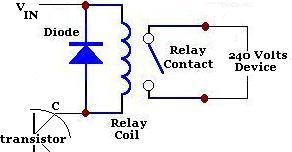
A Light Dependent Resistor ( LDR, photoconductor, or photocell) is a device which has a resistance which varies according to the amount of light falling on its surface.
They will be having a resistance of 1 MOhm in total darkness, and a resistance of a 1 to 10 of kOhm in bright light.
A photoelectric device can be either intrinsic or extrinsic.
Applications:
An LDR can even be used in a simple remote control circuit using the backlight of a mobile phone to turn on a device - call the mobile from anywhere in the world, it lights up the LDR, and lighting can be turned on remotely!
Light Dependent Resistor Circuits:
There are two basic circuits using light dependent resistors - the first is activated by darkness, the second is activated by light.
In the circuit diagram on the left , the led lights up whenever the LDR is in darkness. The 10K variable resistor is used to fine-tune the level of darkness required before the LED lights up. The 10K standard resistor can be changed as required to achieve the desired effect, although any replacement must be at least 1K to protect the transistor from being damaged by excessive current.
The circuits shown above are not practically useful. In a real world circuit, the LED (and resistor) between the positive voltage input (Vin) and the collector (C) of the transistor would be replaced with the device to be powered.

Typically a relay is used - particularly when the low voltage light detecting circuit is used to switch on (or off) a 240V mains powered device. A diagram of that part of the circuit is shown above. When darkness falls (if the LDR circuit is configured that way around), the relay is triggered and the 240V device - for example a security light - switches on.
Measure Light Intensity using Light Dependent Resistor (LDR):
The relationship between the resistance RL and light intensity Lux for a typical LDR is RL = 500 / Lux Kohm
With the LDR connected to 5V through a 3.3K resistor, the output voltage of the LDR is
Vo = 5*RL / (RL+3.3)
Reworking the equation, we obtain the light intensity
Lux = (2500/Vo - 500)/3.3




Comments
indexnewbacklinks
You can order such products from here buy wire